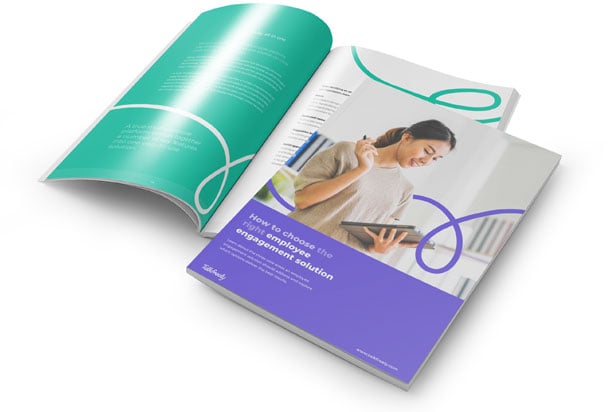So, you’re putting time, effort and budget into your internal communications. But how can you assess whether all this investment is actually paying off? Monitoring employee engagement levels is an essential part of any internal communication strategy. In fact, conducting an internal communications survey is crucial for any organisation that wants to understand exactly what their employees think of the company, their jobs and their role within the organisation.
According to CEB/Gartner research, 92% of businesses conduct an employee communication survey and consider it an important element of their internal communications plan. Regularly evaluating employee engagement helps companies achieve real increases in both revenues and profitability, in the same way measuring sales figures and financial reports do.
The need for effective employee communication surveys has never been greater. The nature of internal communications has changed significantly over the course of the pandemic, with a focus on work-from-home policies and public health initiatives. Communicating change is a complex and sensitive issue. With health and safety a primary concern, internal communications teams need to know they’re reaching their remote colleagues. And they need to have a firm grasp of what success looks like. They need an employee survey communication plan that’s tailored to the new business landscape.
The bottom line? It’s essential to keep a very close eye on the health of your company work culture. Internal communication surveys will have a considerable influence on the overall success of your organisation.
Why are surveys so important?
1. They give employees a voice
Simply providing employees with a channel for open feedback will improve staff morale. Filling in an internal communications survey questionnaire gives them a chance to be heard and be understood. When face-to-face opportunities for feedback are no longer possible on a daily basis, it’s even more vital to provide a platform for the employee voice.
Without this opportunity in place, you are effectively telling employees that you don’t care about their thoughts and ideas. Two-way communication lies at the heart of all effective internal communication. This reciprocal conversation between employees and leaders makes staff realise their opinions are valued.
2. They drive change
Once you know how your organisation is performing in areas such as management effectiveness, employee satisfaction and office environment, you then have actionable data to initiate change. Include these internal communications survey questions, and you’ll have the information you need. With so many employees working from home, it’s essential to have your finger on the pulse when it comes to this crucial level of insight.
Having a handle on engagement levels will allow you to identify areas of best practice. If you have a specific department rating high on employee engagement, it gives you the opportunity to delve into how this has been achieved and how it can be replicated. When it comes to improving internal communication, identifying best practices is often the most direct route to success.
3. They identify weaknesses
A staff communication survey will also help you troubleshoot. Whether you have a department scoring low on engagement or a management issue, internal communications survey questions often highlight problem areas. You’re less likely to spot potential problems in a remote workforce, so these employee communication survey questions will identify issues.
Internal communications surveys can be used as diagnostic instruments. With their insider knowledge, employees can provide vital information about day-to-day operations and the areas that require improvement. Surveys will help pinpoint specific hot spots, such as internal communication channels that have become out of date or a manager who fails to communicate effectively.
The key questions to ask
The questions to ask for an internal communication survey are as important as the survey itself. Facebook discovered that 95% of employees completed their engagement survey, whereas only two-thirds filled out their annual diversity survey. People will respond to questions on issues that matter most to them.
Many surveys focus on a positive response, such as staff happiness levels. However, a purely positive outlook may not yield sufficient information to act on. Internal communication survey questions should always keep the main drivers of employee performance in mind.
1. Connecting to company goals
“Do you know what you should do to help the company meet its goals and objectives?”
Your employees need to know how they personally fit into your overall business strategy. It’s worth remembering that your plans may have changed considerably since March 2020, and your new objectives will need to be stated clearly. Your internal communication survey template should include questions that allow employees to express how they contribute to these goals.
2. Peer to peer commitment
“Does your team help you to complete your work?”
A successful team will work well together and learn from each other. Your internal communications survey questions need to explore whether employees can collaborate easily with colleagues both locally and globally. And if not, you need to know why not. Perhaps you need to put new internal communication tools in place to facilitate collaboration between office-based and remote employees.
3. Developing the right capabilities
“Do you have a good understanding of informal structures and processes at the organisation?”
Your employees will only deliver their best work if they fully understand their role. Your questions should assess whether they have good access to the tools, resources and training provided and whether these resources are suitable for each individual. It is the role of internal communication to ensure high levels of understanding throughout the organisation.
4. Coping with the unexpected
“When something unexpected comes up in your work, do you usually know who to ask for help?”
A particularly pertinent question for today’s workforce and one that has been tested to the limit. While the other questions relate to processes, this one assesses how well your organisation communicates. If your employees know who to turn to when unforeseen challenges arise, you know your company is communicating successfully. This is one of the internal communications survey sample questions that really highlights the importance of internal communication.
Constructing your internal communications survey
Before you start building your employee engagement survey communication plan, consider these four critical elements:
1. Length
When it comes to your internal communications survey, less is more. Keep it short and simple. One of the common internal communication mistakes is to load your survey with a never-ending list of complex questions. Your remote teams, already battling with their work-life balance, will thank you for a concise, to-the-point survey.
Too many questions, repetition, and confusing language will all have a negative effect on your response rates. The questions to ask in an employee engagement survey communication should be simple, using terminology familiar to all employees. Try not to include more than 75 questions as a maximum. The survey should take no longer than 20-30 minutes to complete. Any longer and you’ll find response rates drop through the floor.
Consider diving right into the heart of the issue with an eNPS question. Your Employee Net Promoter Score is a feedback metric derived from the employee survey question below.
“On a scale of zero to ten, how likely is it that you would recommend this organisation as a place to work?”
Always follow this up with a second question; after giving their numerical rating, employees are asked why they chose that response.
2. Frequency
Little and often is what you’re aiming for. Recent research from Achievers revealed that only 11% of employers survey employees more than once a year. Annual survey data is simply not enough in today’s ever-changing workplace. In reality, the data will be outdated before the survey is even closed.
With the government guidance changing almost daily, and new procedures being introduced at a moment’s notice, it’s critical to increase the frequency of your internal communications surveys. You need to have a firm understanding of the employee mood from one week to the next and be ready to support them when required. Right now, it is internal communications best practice to check in on your workers as often as possible.
When constructing employee communication surveys, you should plan to collate feedback on a regular, scheduled basis. This is an area where an internal communications app can really assist with your planning. With built-in modules for feedback and engagement monitoring, you can effortlessly pre-schedule regular surveys and polls.
An employee app will allow you to send survey requests directly to each employee, in the same format, at the same time. In addition, the feedback you receive is in real-time, enabling you to gauge opinion at that precise moment.
3. Reach
It’s vital to ensure your internal communication survey questionnaire reaches every single employee. Too often, an employee survey communication only accesses a core group of employees, leaving the hard-to-reach employees without a voice. The move to remote working has only highlighted this issue.
An internal communications app removes barriers by employees to use their favourite means of communication, whichever hardware or software platform they prefer. By connecting with every employee wherever they are - at home, at work or on the move - you can ensure your survey is covering all bases.
It’s also essential to make sure all workers are receiving the same information at the same time. You need to reach your remote workers at the same time as your office-based workers. Internal communications software promotes equality by delivering the survey to everyone instantly. No one needs to feel left out of the loop.
4. Type
There are many ways to go about constructing an internal communications survey questionnaire. You can ask fundamental, in-depth questions such as the ones highlighted above. Alternatively, you can conduct quick polls or schedule regular ‘pulse’ surveys for a business health check. With internal communications software in place, you can easily implement all three on a rolling basis:
Surveys
Create simple or advanced logic surveys that reach every employee. Feature-rich survey modules include question routing, answer validation, weighted responses, multiple-choice answers and scales. Pick the one which best suits your requirements and mix them up for variety.
Polls
Send out quick single-question polls to capture employee views. You can also enable anyone to create their own poll using a simple form and then display the results in a simple summary chart. Polls are ideal for gaining flash insights across the company and instantly gathering essential internal communications metrics.
Pulse
Measure the ongoing health of your organisation with scheduled check-ups. You can use simple smileys for tracking happiness levels or design your own company health indicators using scaled measurement, e.g. 1-10.
An employee app will make the most of all the internal communication channels at your disposal, putting direct communication into the hands of every employee. You’ll have instant dashboards, team comparisons and in-depth reports to hand – everything you need to evaluate the success of your internal communication strategy. It’s an easy way to implement your employee communication surveys on a regular basis.
When you’re looking to improve internal communications, your first consideration should be gathering feedback and monitoring engagement levels. Without a way to measure the effectiveness of your communications, you will be unable to adjust your strategy and improve your approach. An internal communications survey will help you to continually evaluate the impact of your messages. By delving into what your employees are really thinking, you’ll have your finger firmly on the pulse of your business.
Topics:
Internal Communications









